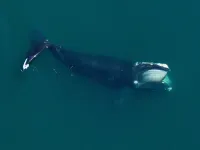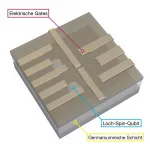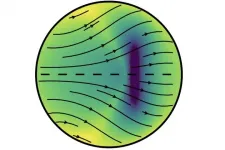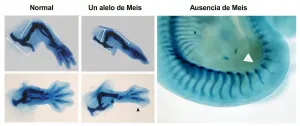(Press-News.org) Using a piece of magnet, researchers have designed a simple system that can control the movement of a small puddle of water, even when it's upside down. The new liquid manipulation strategy, described in the journal Cell Reports Physical Science on June 3, can have a wide range of applications including cleaning hard-to-reach environments or delivering small objects.
Previous attempts to control the movement of fluids often relied on special platforms. For example, on a surface that has one section more hydrophobic than another, water will spontaneously move away from the area and flow toward the more hydrophilic side. Scientists have also used external stimuli such as heat or light to direct the movement of liquids. But fluids in these systems tend to move at a slow speed, and they cannot stop at random during the process. In addition, these approaches usually require materials and instruments that are difficult to obtain, so they are mostly limited to laboratory use.
Yifan Si, the paper's first author and a postdoctoral fellow at the City University of Hong Kong, designed a new device with his team that used a tiny iron bead with an extremely hydrophilic surface. When put in a water droplet, the bead, which measures about 1 millimeter in diameter, will attract water to wrap around it.
The team named the water-enveloped bead Hydrobot, and they put it on an extremely hydrophobic surface. Using a piece of magnet placed underneath the surface, researchers drove the hydrophilic bead, as well as the water droplet adhered to it, to move in all directions and stop at any given time. The bead could move at as fast as 2 meters per second without losing the water stuck on its surface.
"The idea of Hydrobot was inspired by little fish bouncing on and off lotus leaves," Si says. "We have a pond on campus with many lotus plants, and occasionally I would see fish get trapped on these big, hydrophobic leaves. When they manage to escape and jump back in the pond, the water puddle around the fish on the leaves will also be taken away."
Fish scales are highly hydrophilic and can tightly adhere to water, especially on a hydrophobic surface. Inspired by this natural phenomenon, Si and his team designed Hydrobot.
While the 1-millimeter bead could only carry a droplet, Hydrobot's capacity can improve by increasing the bead's surface area. Researchers experimented with a 2-millimeter bead and found that it could manipulate up to 1 milliliter of water, about the size of a small puddle, to follow the movement of the external magnet.
"One advantage of Hydrobot is that the materials involved are easily accessible. If a task requires controlling a larger amount of water, we can simply use more beads to increase the surface area," Si says.
The team also tested Hydrobot upside down by placing the water droplet and the bead underneath the surface and the magnet on the top. The magnet above the surface managed to attract the iron bead, and the high surface adhesion force between bead and water stopped the droplet from falling, despite gravity. In the inverted system, Hydrobot could still move at a speed of 2 centimeters per second.
Because Hydrobot can be controlled with precision, the team proposes that the device can be used to collect dust and clean surfaces. They conducted a conceptual experiment in which the team sprinkled blue-colored dust on an extremely hydrophobic surface. Hydrobot rolled around, following the movement of the magnet underneath, to gather all the dust grains. Eventually, Hydrobot cleaned the surface without damage and returned to its starting point.
So far, Hydrobot requires a low-adhesion surface to operate, such as the superhydrophobic one used in the experiments. This limits where the device can be used, but the team plans to further explore other real-world applications.
"Hydrobot may offer some new ideas to soft robot design," Si says. "Currently, most soft robots use solid materials. Even though they are flexible, they would not be as flexible as liquids. Liquids also have characteristics that can be advantageous, including their ability to change shapes and vaporize. With more studies, these features can make Hydrobot even more versatile."
INFORMATION:
This research was funded by the National Natural Science Foundation of China.
Cell Reports Physical Science, Si et al.: "Bioinspired magnetically driven liquid manipulation as microrobot" https://www.cell.com/cell-reports-physical-science/fulltext/S2666-3864(21)00134-X
Cell Reports Physical Science (@CellRepPhysSci), published by Cell Press, is a new broad-scope, open access journal that publishes cutting-edge research across the spectrum of the physical sciences, including chemistry, physics, materials science, energy science, engineering, and related interdisciplinary work. Visit: https://www.cell.com/cell-reports-physical-science/home. To receive Cell Press media alerts, please contact press@cell.com.
Anyone that's ever interacted with a dog knows that they often have an amazing capacity to interact with people. Now researchers reporting in the journal Current Biology on June 3 have found that this ability is present in dogs from a very young age and doesn't require much, if any, prior experience or training. But, some of them start off better at it than others based on their genetics.
"We show that puppies will reciprocate human social gaze and successfully use information given by a human in a social context from a very young age and prior to extensive experience with humans," said Emily E. Bray of the University of Arizona, Tucson. "For example, even before puppies have left their littermates to live ...
Whales are largely protected from direct catch, but many populations' numbers still remain far below what they once were. A study published in the journal Current Biology on June 3 suggests that, in addition to smaller population sizes, those whales that survive are struggling. As evidence, they find that right whales living in the North Atlantic today are significantly shorter than those born 30 to 40 years ago.
"On average, a whale born today is expected to reach a total length about a meter shorter than a whale born in 1980," said Joshua Stewart of the National Oceanic and Atmospheric Administration (NOAA) in La Jolla, CA. That represents an average decline in length of about 7%. "But that's just the average--there are also some extreme cases where young whales are several ...
Patients who, perhaps unbeknownst to their health care providers, are in need of genetic testing for rare undiagnosed diseases can be identified en masse based on routine information in electronic health records (EHRs), a research team reported today in the journal Nature Medicine.
Findings from the Vanderbilt University Medical Center study suggest that, among the patients of any sizeable health care system, there are hundreds or thousands with undiagnosed rare diseases of the sort where a genetic test could lead to a diagnosis.
"Patients with rare genetic diseases often face ...
What The Study Did: Changes in pregnancy and birth rates before and after COVID-19 lockdown measures were estimated using electronic medical records.
Authors: Molly J. Stout, M.D., of the University of Michigan in Ann Arbor, is the corresponding author.
To access the embargoed study: Visit our For The Media website at this link https://media.jamanetwork.com/
(doi:10.1001/jamanetworkopen.2021.11621)
Editor's Note: Please see the article for additional information, including other authors, author contributions and affiliations, conflict of interest and financial disclosures, and funding and support.
INFORMATION:
Media advisory: The full study is linked to this news release.
Embed this link to provide your readers free access ...
Quantum computers with their promises of creating new materials and solving intractable mathematical problems are a dream of many physicists. Now, they are slowly approaching viable realizations in many laboratories all over the world. But there are still enormous challenges to master. A central one is the construction of stable quantum bits - the fundamental unit of quantum computation called qubit for short - that can be networked together.
In a study published in Nature Materials and led by Daniel Jirovec from the Katsaros group at IST Austria in close collaboration with researchers from the L-NESS Inter-university Centre in Como, Italy, scientists now have created a new and promising candidate system for reliable qubits.
Spinning Absence
The researchers created the qubit using the ...
Dogs may have earned the title "man's best friend" because of how good they are at interacting with people. Those social skills may be present shortly after birth rather than learned, a new study by University of Arizona researchers suggests.
Published today in the journal Current Biology, the study also finds that genetics may help explain why some dogs perform better than others on social tasks such as following pointing gestures.
"There was evidence that these sorts of social skills were present in adulthood, but here we find evidence that puppies - sort of like humans - are biologically prepared to interact in these social ways," said lead study author Emily Bray, a postdoctoral research associate in the UArizona School of Anthropology in the College of Social and Behavioral ...
(Toronto, June 3, 2021) -- The impact of deploying Artificial Intelligence (AI) for radiation cancer therapy in a real-world clinical setting has been tested by Princess Margaret researchers in a unique study involving physicians and their patients.
A team of researchers directly compared physician evaluations of radiation treatments generated by an AI machine learning (ML) algorithm to conventional radiation treatments generated by humans.
They found that in the majority of the 100 patients studied, treatments generated using ML were deemed to be clinically acceptable for patient treatments by physicians.
Overall, 89% of ML-generated treatments were considered clinically acceptable for treatments, ...
For reasons unknown, Earth's solid-iron inner core is growing faster on one side than the other, and it has been ever since it started to freeze out from molten iron more than half a billion years ago, according to a new study by seismologists at the University of California, Berkeley.
The faster growth under Indonesia's Banda Sea hasn't left the core lopsided. Gravity evenly distributes the new growth -- iron crystals that form as the molten iron cools -- to maintain a spherical inner core that grows in radius by an average of 1 millimeter per year.
But the enhanced growth on one side suggests that something in Earth's outer core or mantle under Indonesia is removing heat from the inner core at a faster rate than on the opposite side, under Brazil. Quicker cooling on one side would ...
Scientists at the Centro Nacional de Investigaciones Cardiovasculares (CNIC), working in partnership with researchers at the Institut de Recherches Cliniques de Montréal (IRCM) in Canada, have identified Meis transcription factors as essential biomolecules for the formation and antero-posterior patterning of the limbs during embryonic development.
In the study, published in Nature Communications, the research team carried out an in-depth characterization of the Meis family of transcription factors. Genetic deletion of all four family members showed that these proteins are essential for the formation of the limbs during embryonic development. "An embryo that develops in the absence of Meis does not ...
Regular strength and impact-type training may decrease or even prevent age-related bone deterioration in men, new research at the University of Jyväskylä, Finland, shows. The tibial bone properties of middle-aged and older male sprint athletes were followed over 10 years. The study presents novel findings on maintaining the adaptability of the aging skeleton and on the importance of regular intensive training for maintaining bone health.
"Part of the age-related bone loss is probably explained by reduced levels of physical activity. Especially intensive, bone-loading exercise ...







